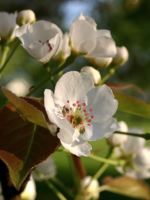Mon-Fri 9am - 5pm Mountain time
Ussurian Pear (Siberian) vs Dahurian Birch
Pyrus ussuriensis
Betula davurica
NOT AVAILABLE THIS SEASON - MIGHT RETURN
CUSTOM GROW
Ussurian Pear is the most cold hardy of all pear species. It is frequently used as a rootstock or as a pollinizer for other pear varieties. The pinkish-white flowers that bloom in the spring and the striking fall colours make it well-suited as an ornamental addition to your landscape.
Ussurian Pear can also be used for forming hedges as it tends to branch quite low.
While the Ussurian Pear is considered self-pollinating, planting with another pear variety will increase yields. Can be paired with Krazulya Pear or Beedle Pear.
Dahurian Birch is a rare and interesting ornamental with curling bark. This tree is the first to sprout on bare land and is tolerant of dry, gravelly, and infertile soils. Dahurian Birch can grow in industrial areas or exposed land as long as it has full sunlight.
This tree is ideal for landscaping, ornamental, and ecosystem services.
This tree is not well known, but is a favorite of nursery owners across the country.

